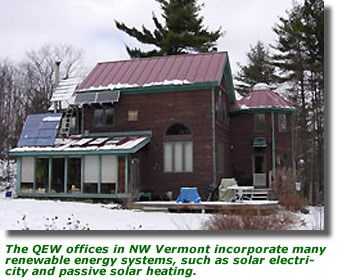


| QEW Organization | QEW History | By-Laws | Staff | Offices | Projects | ||
|---|---|---|
THE OFFICES OF QEW are located in the home of General Secretary Ruah Swennerfelt and Publications Coordinator Louis Cox in Charlotte, Vt. Their telecommuitng has kept the organization's operating costs low by reducing car travel into Burlington, about 17 miles away, to only a couple of times a week to pick up QEW mail and do errands. On the south side of the house is a sunroom that does triple service as a solar heat collector, a gardening hothouse, and living space. We have plans and some used equipment for solar water heating to be installed in the near future. We are also investigating the feasibility of supplemental wind power. In the photo you can also see the fourteen 55-watt and two 120-watt photovoltaic solar panels that give us a total of about 1,000 kilowatts of collector capacity. Direct current (DC) is stored in a 24-volt bank of deep-cycle lead-acid batteries. A sophisticated electronic device called an inverter allows us to tap some of this stored energy as alternating current (AC) for running office equipment, kitchen appliances, shop tools, lights, water pump, etc. What you can't see in the photo is that we are entirely off the electric grid! This means occasional inconvenience of not having all the power we could use. At the same time, we enjoy security from power outages during ice storms and grid malfunctions. And it's good to know that we're producing "green" energy. We struggle through quite a lot of cloudy and overcast weather in the winter months (less than half the solar gain that someone in, say, Phoenix, Arizona, would get). This requires us to manage home and office functions on about 10 percent of the electrical use of the typical North American family! Several times a month during the winter we are forced to top up the batteries by running a gasoline-powered generator for several hours, when it is important to keep the QEW offices functioning. Our household energy management involves 1) high efficiency equipment, 2) conservation, 3) energy-smart design, and 4) alternative sources. High-efficiency equipment FOR ALL OF OUR LIGHTING we use energy-efficient compact fluorescent lights (CFLs), which use only about 25 percent as much electricity as incandescents and save even more money by lasting about 10 times as long. We also have a number of direct-current lights, which we can use when there is no other need for the DC/AC inverter (which by itself uses the power equivalent of three CFLs). We also use energy-efficient laptop LCD-screen computers and other "Energy Star" office equipment. We are looking into installing some LED lighting as well. Our state-of-the-art front-loading clothes washer uses only a fraction of the energy and water that conventional top-loaders use. Our Jotul Alpha wood space heater burns hot and clean, reducing our firewood needs and minimizing flue emissions. Although we still use propane for water heating, we have a highly efficient Aqua-Star tankless heater that burns only when the hot-water is running. When we hook up our solar water heater, we will be able to feed pre-heated water into the Aqua-Star.
Conservation THE LIST OF WAYS to conserve energy is endless, but here are some of the areas that we emphasize: Gearing our activities to daylight hours to reduce the amount of articificial lighting; turning off lights and other devices when they're not needed; collecting rainwater for gravity-powered garden irrigation; saving shower water for toilet flushing; closing insulated shades at night to retain heat; and reading and playing board games instead of watching television (conserving time and sanity at the same time). Energy-smart design THE SOLAR-ORIENTATION and stratetic placement of windows should be a no-brainer, but, alas, few buildings even today are sited and designed on this principle. The house was also tightly constructed with R-38 cellulose insulation in six-inch walls. Most of the windows incorporate low-e thermal glazing. The two-story traditional "salt box " style minimizes heat loss, shelters the house from north winds in the winter, and facilitiates natural ventilation. Alternative energy sources BECAUSE PHOTOVOLTAIC EQUIPMENT is very expensive, we have kept the system small by using a propane-powered refrigerator (Dometic brand) and a propane kitchen range. Since propane is a fossil fuel, we are looking for other earth-friendlier alternatives. Who knows, maybe ice houses and wood ranges will make a comeback! Again, the list of alternatives to fossil fuels is endless. But some of important ones are: substituting muscle power (we use a hand carpet sweeper, reel-type push mower, hand garden tools, etc.); using a microwave oven, toaster, and tea kettle during sunny periods when we have a surplus of stored electricity; and walking and bicycling when possible. We also listen to news and music on a good-quality battery powered radio when the solar power reserves are low. Most important about being an off-grid solar home is that it makes us very conscious and sensitive to the cycles and rhythms of nature, which is central to the vision and witness of QEW. We find ourselves adjusting our lifestyles as circumstances require rather than trying to impose our needs and will on nature, a key to ecological sustainability. A lot of our time is spent managing and maintaining these alternative energy systems, but overall we experience a physically healthy and psychologically satisfying quality of life, as we follow the Light to live in greater harmony with the earth. —Louis Cox
|

